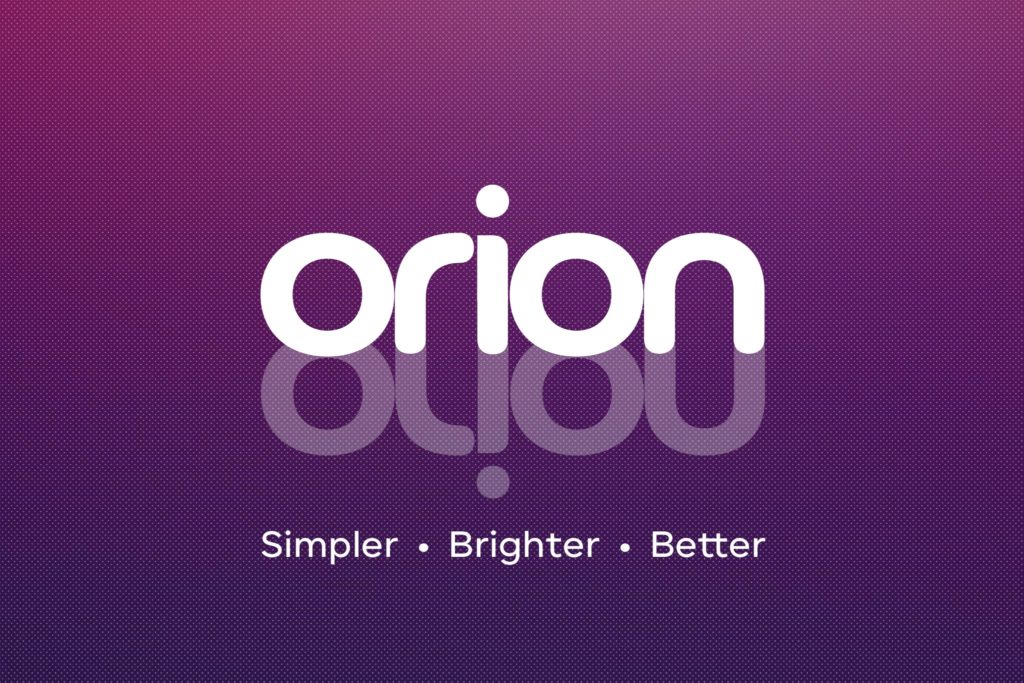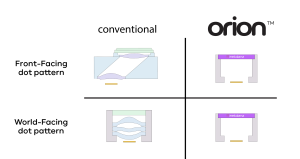Metalenz Launches Orion(TM) Product Family of Dot Pattern Projectors Using Patented Metasurface Technology
Using Metalenz's patented metasurface technology, the Orion product family is a simplified and more efficient solution that is bound to displace refractive lens and diffractive element optical stacks with a single meta-optic.

Boston, MA, May 27, 2021 --(PR.com)-- Metalenz’s simpler dot projectors enable 3D sensing to proliferate to all smartphones.
Metalenz has secured high volume manufacturing partnerships and has customers in the queue, with broad availability of evaluation kits in June.
Metalenz Inc., the pioneer in metasurface design and commercialization, today unveiled the Orion(TM) product family, the world’s simplest, high performance dot projectors. Current dot projectors, used in mobile devices for features like facial recognition and 3D sensing, have been a logistic and aesthetic headache for cell phone manufactures--eating up valuable space, interrupting the phone display and requiring complex assembly of many different components. Using its patented metasurface technology, the Orion product family is a simplified and more efficient solution that is bound to displace refractive lens and diffractive element optical stacks with a single meta-optic.
“If you look at dot projectors in cell phones today, these are some of the most complex and bulky modules in the phone,” said Robert Devlin, co-founder/CEO, Metalenz. “The size, complexity and cost has limited 3D sensing and face unlock to just the top tier cell phone companies. What Metalenz provides with our meta-optic technology is the simplest possible approach. We’re able to improve the system level performance while replacing as many as six optics in the current modules with a single meta-optic. This results in a size reduction in all three dimensions. Ultimately, the Orion product line will enable under-display sensing and allow much broader adoption of 3D sensing and face unlock features across all cell phones.”
Metalenz’s patented Orion product line is set to replace current 3D optical configurations in smartphones because of its advantages:
- Simpler – replaces as many as six optical parts in an illumination system (refractive lenses, mirrors, DOE) with a single meta-optic piece.
- Smaller – collapses form factor to fit in the tightest of spaces, hiding under screens or in the tiniest of nooks in a phone.
- Brighter – light projected to where it is needed the most for high resolution constellations or out far out distances, balancing performance and power savings.
- Better – architecture drastically lowers assembly complexity and cost to drive more depth sensing sockets for user authentication and AR.
The advantages of Orion products extend to both structured light (SL) and time of flight (ToF) 3D depth sensing solutions. The meta-optics improve system level signal-to-noise-ratio, resulting in better performance in sunlight, higher resolution, longer sensing distances, and improved battery life.
The Orion 50(TM), the highest dot density product in the family, boasts more than 50,000 projected dots with an optical module height thin enough for the most advanced mobile devices. It radically simplifies what has traditionally been a six element stack (four refractive lenses, mirrors to achieve a folded optical path, and a DOE) into one single meta-optic system. Orion 50 means component reduction, tiny size, performance we are accustomed to, and dramatically easier manufacturing. This simplification will enable more phone makers to put sensors and cameras beneath a device's glass display and ultimately in the palms of our hands.
On the flip side, smartphones with world-facing (a.k.a the back of the phone) 3D depth sensing cameras deliver professional looking photography effects like bokeh and are enabling emerging AR applications. Depth sensing cameras rely on active illumination of the scene with lasers and capture of reflected light with specialized ToF sensors. Illuminating brighter to cover greater distances and flooding the scene for long periods of time can be a major drain on a phone's battery life. These are the antithesis of bringing forth more immersive and encompassing AR applications.
Orion 2.5(TM) projects 2,500 high intensity dots into the scene so more light will travel the distance back to the image sensor. High resolution depth information is made possible at distances of 10 meters or more. Orion 2.5 conserves power and enables a new arena for AR in smartphones, head mounted displays, and consumer electronics. It stays true to the Orion family roots - simpler, brighter, better optics - while doing away with system complexity and driving down the barriers for integration and board adoption.
With its recent flat-lens technological achievements, manufacturing partnerships in place, and growing customer list, Metalenz is poised to revolutionize sensing in smartphones and consumer electronics.
Evaluation kits of Orion will be available in late June. Contact sales@metalenz.com for more information.
About Metalenz
Metalenz, founded in 2016, is the first company to commercialize meta-optics. The company is backed by leading investors including 3M, Applied Ventures LLC, Intel Capital, M Ventures and TDK Ventures. The company has the exclusive worldwide license to the portfolio of foundational intellectual property relating to metasurfaces developed in the Capasso Lab at Harvard University and has more than 20 patents on innovations that simplify and improve optical devices across multiple markets. Recently featured in TechCrunch, Wired, The New York Times, and Forbes. For more information, please visit https://www.metalenz.com/
media@metalenz.com
Metalenz has secured high volume manufacturing partnerships and has customers in the queue, with broad availability of evaluation kits in June.
Metalenz Inc., the pioneer in metasurface design and commercialization, today unveiled the Orion(TM) product family, the world’s simplest, high performance dot projectors. Current dot projectors, used in mobile devices for features like facial recognition and 3D sensing, have been a logistic and aesthetic headache for cell phone manufactures--eating up valuable space, interrupting the phone display and requiring complex assembly of many different components. Using its patented metasurface technology, the Orion product family is a simplified and more efficient solution that is bound to displace refractive lens and diffractive element optical stacks with a single meta-optic.
“If you look at dot projectors in cell phones today, these are some of the most complex and bulky modules in the phone,” said Robert Devlin, co-founder/CEO, Metalenz. “The size, complexity and cost has limited 3D sensing and face unlock to just the top tier cell phone companies. What Metalenz provides with our meta-optic technology is the simplest possible approach. We’re able to improve the system level performance while replacing as many as six optics in the current modules with a single meta-optic. This results in a size reduction in all three dimensions. Ultimately, the Orion product line will enable under-display sensing and allow much broader adoption of 3D sensing and face unlock features across all cell phones.”
Metalenz’s patented Orion product line is set to replace current 3D optical configurations in smartphones because of its advantages:
- Simpler – replaces as many as six optical parts in an illumination system (refractive lenses, mirrors, DOE) with a single meta-optic piece.
- Smaller – collapses form factor to fit in the tightest of spaces, hiding under screens or in the tiniest of nooks in a phone.
- Brighter – light projected to where it is needed the most for high resolution constellations or out far out distances, balancing performance and power savings.
- Better – architecture drastically lowers assembly complexity and cost to drive more depth sensing sockets for user authentication and AR.
The advantages of Orion products extend to both structured light (SL) and time of flight (ToF) 3D depth sensing solutions. The meta-optics improve system level signal-to-noise-ratio, resulting in better performance in sunlight, higher resolution, longer sensing distances, and improved battery life.
The Orion 50(TM), the highest dot density product in the family, boasts more than 50,000 projected dots with an optical module height thin enough for the most advanced mobile devices. It radically simplifies what has traditionally been a six element stack (four refractive lenses, mirrors to achieve a folded optical path, and a DOE) into one single meta-optic system. Orion 50 means component reduction, tiny size, performance we are accustomed to, and dramatically easier manufacturing. This simplification will enable more phone makers to put sensors and cameras beneath a device's glass display and ultimately in the palms of our hands.
On the flip side, smartphones with world-facing (a.k.a the back of the phone) 3D depth sensing cameras deliver professional looking photography effects like bokeh and are enabling emerging AR applications. Depth sensing cameras rely on active illumination of the scene with lasers and capture of reflected light with specialized ToF sensors. Illuminating brighter to cover greater distances and flooding the scene for long periods of time can be a major drain on a phone's battery life. These are the antithesis of bringing forth more immersive and encompassing AR applications.
Orion 2.5(TM) projects 2,500 high intensity dots into the scene so more light will travel the distance back to the image sensor. High resolution depth information is made possible at distances of 10 meters or more. Orion 2.5 conserves power and enables a new arena for AR in smartphones, head mounted displays, and consumer electronics. It stays true to the Orion family roots - simpler, brighter, better optics - while doing away with system complexity and driving down the barriers for integration and board adoption.
With its recent flat-lens technological achievements, manufacturing partnerships in place, and growing customer list, Metalenz is poised to revolutionize sensing in smartphones and consumer electronics.
Evaluation kits of Orion will be available in late June. Contact sales@metalenz.com for more information.
About Metalenz
Metalenz, founded in 2016, is the first company to commercialize meta-optics. The company is backed by leading investors including 3M, Applied Ventures LLC, Intel Capital, M Ventures and TDK Ventures. The company has the exclusive worldwide license to the portfolio of foundational intellectual property relating to metasurfaces developed in the Capasso Lab at Harvard University and has more than 20 patents on innovations that simplify and improve optical devices across multiple markets. Recently featured in TechCrunch, Wired, The New York Times, and Forbes. For more information, please visit https://www.metalenz.com/
media@metalenz.com
Contact
Metalenz
Carlos Calvo
857-301-8510
metalenz.com
Carlos Calvo
857-301-8510
metalenz.com
Multimedia
Categories

